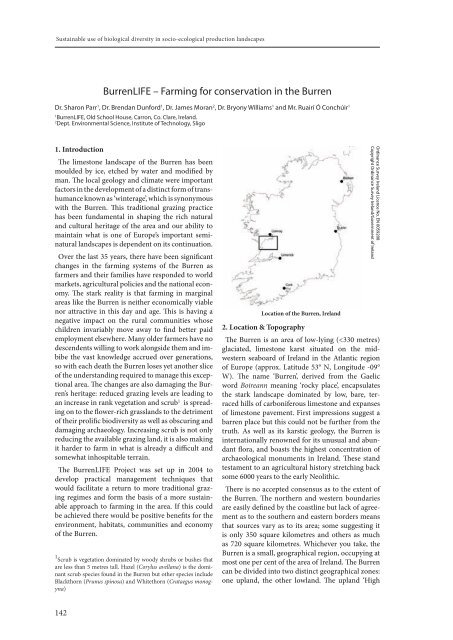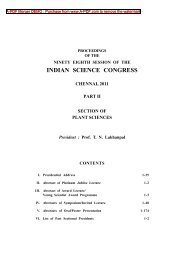sustainable use of biological diversity.pdf - India Environment Portal
sustainable use of biological diversity.pdf - India Environment Portal
sustainable use of biological diversity.pdf - India Environment Portal
You also want an ePaper? Increase the reach of your titles
YUMPU automatically turns print PDFs into web optimized ePapers that Google loves.
Sustainable <strong>use</strong> <strong>of</strong> <strong>biological</strong> <strong>diversity</strong> in socio-ecological production landscapes<br />
BurrenLIFE – Farming for conservation in the Burren<br />
Dr. Sharon Parr 1 , Dr. Brendan Dunford 1 , Dr. James Moran 2 , Dr. Bryony Williams 1 and Mr. Ruairí Ó Conchúir 1<br />
1<br />
BurrenLIFE, Old School Ho<strong>use</strong>, Carron, Co. Clare, Ireland.<br />
2<br />
Dept. <strong>Environment</strong>al Science, Institute <strong>of</strong> Technology, Sligo<br />
1. introduction<br />
The limestone landscape <strong>of</strong> the Burren has been<br />
moulded by ice, etched by water and modified by<br />
man. The local geology and climate were important<br />
factors in the development <strong>of</strong> a distinct form <strong>of</strong> transhumance<br />
known as ‘winterage’, which is synonymous<br />
with the Burren. This traditional grazing practice<br />
has been fundamental in shaping the rich natural<br />
and cultural heritage <strong>of</strong> the area and our ability to<br />
maintain what is one <strong>of</strong> Europe’s important seminatural<br />
landscapes is dependent on its continuation.<br />
Over the last 35 years, there have been significant<br />
changes in the farming systems <strong>of</strong> the Burren as<br />
farmers and their families have responded to world<br />
markets, agricultural policies and the national economy.<br />
The stark reality is that farming in marginal<br />
areas like the Burren is neither economically viable<br />
nor attractive in this day and age. This is having a<br />
negative impact on the rural communities whose<br />
children invariably move away to find better paid<br />
employment elsewhere. Many older farmers have no<br />
descendents willing to work alongside them and imbibe<br />
the vast knowledge accrued over generations,<br />
so with each death the Burren loses yet another slice<br />
<strong>of</strong> the understanding required to manage this exceptional<br />
area. The changes are also damaging the Burren’s<br />
heritage: reduced grazing levels are leading to<br />
an increase in rank vegetation and scrub 1 is spreading<br />
on to the flower-rich grasslands to the detriment<br />
<strong>of</strong> their prolific bio<strong>diversity</strong> as well as obscuring and<br />
damaging archaeology. Increasing scrub is not only<br />
reducing the available grazing land, it is also making<br />
it harder to farm in what is already a difficult and<br />
somewhat inhospitable terrain.<br />
The BurrenLIFE Project was set up in 2004 to<br />
develop practical management techniques that<br />
would facilitate a return to more traditional grazing<br />
regimes and form the basis <strong>of</strong> a more <strong>sustainable</strong><br />
approach to farming in the area. If this could<br />
be achieved there would be positive benefits for the<br />
environment, habitats, communities and economy<br />
<strong>of</strong> the Burren.<br />
1 Scrub is vegetation dominated by woody shrubs or bushes that<br />
are less than 5 metres tall. Hazel (Corylus avellana) is the dominant<br />
scrub species found in the Burren but other species include<br />
Blackthorn (Prunus spinosa) and Whitethorn (Crataegus monogyna)<br />
location <strong>of</strong> the burren, ireland<br />
2. location & topography<br />
Ordinance Survey Ireland Licence No. EN 0059208<br />
Copyright Ordinance Survey Ireland/Government <strong>of</strong> Ireland<br />
The Burren is an area <strong>of</strong> low-lying (
















